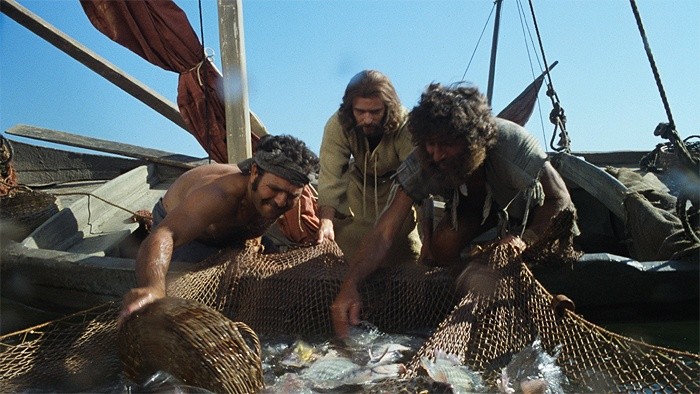Throughout the Gospels, we catch a glimpse of how Jesus discipled others.

Jesus believed in the Twelve despite their common and for some, their sordid, background. Rabbis, at that time, would choose and train the most promising candidates – the best of the best. Jesus took a different strategy. He chose to believe that common and wayward people can become amazing disciples.
Jesus encouraged people to live out their calling. He called Peter and Andrew to be fishers of men. Jesus worked with Peter, in particular, to prepare him to be the rock upon which he would build the Church. There’s something incredibly motivating about knowing God’s plan for our lives. We’re willing to do whatever it takes to prepare and equip ourselves to achieve His desires.
Jesus also spent lots of time with a few people – he really did life with them. There’s something very appealing about discipleship that is organic and naturally takes shape around the ebbs and flows of life. The need to feed a large crowd of people became a lesson on God’s faithful provision. A stormy sea led to a demonstration of Jesus’ divine power and a lesson on having faith even in the face of great fear. Jesus was a master of teachable moments.
Another one of Jesus’ discipleship strategies really emerged from his doing life with people. He orchestrated learning experiences. He used his cursing of the fig tree to teach his disciples about the power of believing prayer. Sitting in the temple with his disciples, Jesus observed a poor widow putting two very small copper coins into the temple treasury. Jesus was astounded and quickly gathered his disciples around him for an impromptu lesson, “This poor widow has put more into the treasury than all the others. They all gave out of their wealth; but she, out of her poverty, put in everything—all she had to live on.” Jesus was a master at turning the situations around him into learning experiences – a very effective approach to experiential learning.
With his apostles, Jesus also used an apprenticeship model. As they watched him do ministry and as they learned from his teaching, they also had opportunity to serve. In Matthew 10, Jesus sends out the Twelve to minister to others. It was now their chance to put into practice what they had heard from and seen in Jesus.
Another discipleship strategy that Jesus used was mentoring. He engaged in group mentoring repeatedly, but he also mentored a select few in an in-depth way. Of the Twelve, Peter, James and John seemed to receive extra attention.
One of Jesus’ mentoring strategies was to ask questions. According to Martin Copenharver, Jesus asked 307 questions. Here are a few examples: Matthew 5:13. “You are the salt of the earth. But if the salt loses its saltiness, how can it be made salty again?” Or Matthew 8:26. “You of little faith. Why are you so afraid?” And then there’s Matthew 26:54. “But how then would the Scriptures be fulfilled that say it must happen in this way?” You see, Jesus used questions to expand people’s thinking.
He also debriefed with his disciples. We see an example of this in Mark 9 after Jesus heals a boy possessed by an evil spirit. The disciples ask Jesus why they couldn’t cast out the demon. Jesus says, “This kind can come out only by prayer.” After any type of service where we have come up against our own limitations, we’re often very open to further instruction. That’s one of the reasons why debriefing is such a good discipleship strategy.
Teaching is another strategy for helping people take next steps and Jesus certainly taught people. The Sermon on the Mount in Matthew 5-7 is a prime example of Jesus teaching his disciples. Yet, Jesus often incorporated images, questions, everyday activities, cultural tensions, political incorrectness, and references to the Jewish Scriptures that would have grabbed people’s attention. He knew how to captivate an audience.
Telling parables, though, was one of Jesus’ favorite approaches. The Parable of the Soils would have been something people could readily envision and relate to in an agrarian society. The Parable of the Good Samaritan tapped into inter-racial tensions. The Parable of the Prodigal Son pointed to the Father’s faithful love for his children, but it was also a slam against the religious leaders as represented by the older judgmental, stand-offish son. Jesus used story-telling in a powerful way to communicate truth. People love stories and it’s still a great strategy to use in our teaching.
The final discipleship strategy I’ll mention is that Jesus empowered people. It’s one thing to teach or mentor, but it’s quite another to actually send people off with a greater conviction and passion to tackle a problem, make a decision, extend forgiveness or whatever is necessary. Think about how the woman caught in adultery would have received Jesus’ words. First, Jesus said to her accusers, “Let any one of you who is without sin be the first to throw a stone at her.” After all the accusers left, Jesus asked, “Woman, where are they? Has no one condemned you?” After she replied no to his second question, Jesus declared, “Then neither do I condemn you. Go now and leave your life of sin.” The only one in the group without sin did not condemn this woman. I can only imagine how this encounter with Jesus might have changed her forever.
Jesus used many ways to disciple others. He believed in people, even the marginalized, and was willing to nurture their potential. Jesus called people and helped them live out their calling. He did life with his disciples and naturally wove life lessons into the fabric of their lives. Jesus had a knack for maximizing teachable moments. This was possible because he adopted an apprenticeship model where his disciples saw him up close, heard both his formal and informal teaching, and mirrored what they saw and heard in real life ministry. Jesus also mentored people one-on-one and in groups. He was forever asking questions that provoked people to think differently. Jesus also took time to debrief with his disciples – to correct or add to their understanding, to encourage, and to motivate them to continue taking next steps. Of course, Jesus also taught people. He masterfully used multiple techniques for engaging with his audience. With all of these discipleship strategies, Jesus sought to empower people to move forward in their mission of loving God, loving others, and making more disciples.
